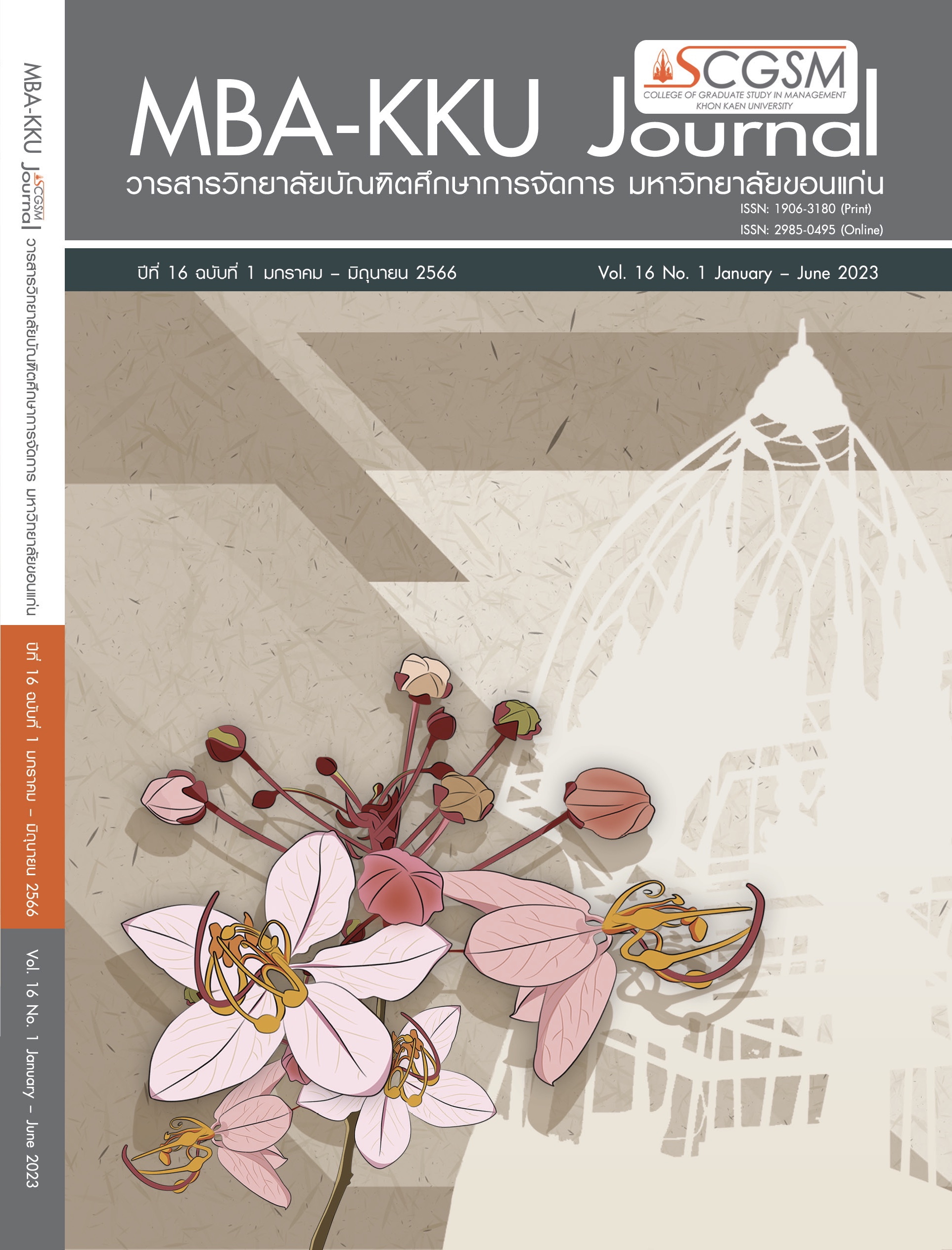Development of Seasoning Insect Products to Add Value to Insects
Main Article Content
Abstract
This study aims to develop seasoned insect products as
a means of adding value to insects. A qualitative research approach was adopted, employing a structured interview form as the research tool. The target participants consisted of representative consumers of seasoned insects. Content analysis was used for data analysis. The results revealed
that for all three types of insects, the roasting technique resulted in the longest-lasting crunchiness and the lowest moisture content. Seasoning power should be separated to prevent the insects from becoming moist. The selected product packaging was a zip lock bag made of BOPP+PET+PP material. The brand name “ME: D” was chosen. The two-syllable name demonstrates legible labeling in both Thai and English, representing high-quality and enjoyable products. Specific flavors including cheese,
barbecue, and seaweed, were determined. A survey on the satisfaction of ten key informants was conducted to gather their opinions on various aspects of seasoned insect products. Regarding the product itself, the key informants
commonly described the insects as crunchy and nutty with a strong flavor although some flavors were perceived as pungent. In terms of pricing, the key informants generally agreed on a price of 30 baht for the seasoned insect product. For the distribution channel, the key informants suggested that community shops were a suitable place for selling the product due to accessibility and lower competition compared to other channels. Regarding
promotion, the key informants mostly emphasized the importance of providing free tastings.
Article Details

This work is licensed under a Creative Commons Attribution-NonCommercial-NoDerivatives 4.0 International License.
- The ideas and opinions expressed in MBA-KKU Journal are those of the authors and not necessarily those of the editor.
- Copyright on any open access article in a journal published by MBA-KKU Journal
References
แก้วมณี อุทิรัมย์, ผกามาศ บุตรสาลี, ทิพย์สุดา ทาสีดำ และอุดมพงษ์ เกดศรีพงษ์ศา. (2562). การเพิ่มมูลค่าแลพัฒนารูปแบบช่องทางการจัดจำหน่ายสินค้าของกลุ่มโรงสีข้าวบ้านหัวดง ตำบลพระเสาร์ อำเภอมหาชนะชัย จังหวัดยโสธร. วารสารวิจัยและพัฒนา มหาวิทยาลัยราชภัฏบุรีรัมย์, 14(2), 111-120.
จิตติรัตน์ แสงเลิศอุทัย. (2558). เครื่องมือที่ใช้ในการวิจัย. วารสารบัณฑิตศึกษา, 12(58), 13-24.
ฉัตยาพร เสมอใจ. (2558). กลยุทธ์ตลาดสำหรับวิสาหกิจชุมชน : กรณีศึกษากระเทียมโทนดอง อบต. บางกร่าง จังหวัดนนทบุรี. วารสารวิชาการ มหาวิทยาลัยราชภัฎพระนคร, 6(2), 104-114.
พงศ์พิพัฒน์ สนม และกมลวรรณ แจงชัด. (2564). ผลของจิ้งหรีดผงโปรตีนถั่วเหลืองสกัดและแซนแทนกัมที่มีต่อคุณภาพคุกกี้แป้งข้าว. วารสารวิชาการและวิจัย มหาวิทยาลัยเทคโนโลยีราชมงคลพระนคร, 14(2), 72-84.
มานพ ชุ่มอุ่น และอาชวิน ใจแก้ว. (2563). การออกแบบตราสินค้า โมเดลธุรกิจ และกลยุทธ์การตลาดเชิงสร้างสรรค์ในผลิตภัณฑ์จากมะเกี๋ยงในจังหวัดเชียงใหม่. วารสารการบัญชีและการจัดการ มหาวิทยาลัยมหาสารคาม, 12(4), 13-29.
รังสิต ฟอยล์ (ม.ป.ป.) ความรู้ทั่วไป : ประเภทถุงบรรจุภัณฑ์ (Packaging bag). ค้นเมื่อ 10 สิงหาคม 2565, จาก rangsitfoil.com/packaging-bag-type/
ศิรินภา เฮ้งบริบูรณ์, อารมณ์ ตัตตะวะศาสตร์ และศักดิ์ชัย เจริญศิริพรกุล. (2559). การวางแผนกลยุทธ์การตลาดเพื่อเพิ่มยอดขายน้ำมะนาวแท้แช่แข็ง ตรา ลาลา เทศบาลนครขอนแก่น จังหวัดขอนแก่น. วารสารวิทยาลัยบัณฑิตศึกษาการจัดการ มหาวิทยาลัยขอนแก่น, 9(2), 158-179.
ศิริพงษ์ ฐานมั่น และนิรินธนา บุษปฤกษ์. (2562). การศึกษาการพัฒนาผลิตภัณฑ์ทางการเกษตรและพฤติกรรมผู้บริโภคโดยกระบวนการวิจัยแบบผสมผสาน. วารสารวิจัยและพัฒนา วไลยอลงกรณ์ในพระบรมราชูปถัมภ์ สาขามนุษย์ศาสตร์และสังคมศาสตร์, 14(1), 111-124.
ศูนย์วิจัยกสิกรไทย. (2563). จิ้งหรีด โอกาสธุรกิจที่รอการสนับสนุน. จากคอลัมน์ Econ Diges. ค้นเมื่อ 28 กรกฎาคม 2565, จาก https://www.kasikornresearch.com/th/analysis/k-social-media/Pages/Protein-FB-2602.aspx
สุภกาญจน์ พรหมขันธ์, สุกัญญา สายธิ และชนิษฏา วงศ์บาสก์. (2563). ผลของสภาวะอบแห้งและอายุการเก็บรักษาผลิตภัณฑ์จิ้งหรีดอบกรอบ. วารสารแก่นเกษตร, 48(1), 1-12.
สุวภัภร ดีอุดม และจรีพร ศรีทอง. (2561). การสำรวจทัศนคติและพฤติกรรมของผู้บริโภคในเขตบางกะปิ กรุงเทพมหานคร เพื่อการออกแบบและผลิตอาหารที่แปรรูปจากจิ้งหรีด. การค้นคว้าอิสระ คณะบริหารธุรกิจ มหาวิทยาลัยรามคำแหง.
อกนิษฐ์ เชยคำดี และชญาภัทร์ กี่อาริโย. (2561). ปัจจัยที่มีความสัมพันธ์กับการตัดสินใจเลือกใช้บริการร้านอาหารติ่มซำ อำเภอเมือง จังหวัดนครศรีธรรมราช. วารสารวิทยาการจัดการ, 5(1), 39-57.
อภิราม คำสด และสาธิต อดิตโต. (2559). พฤติกรรมการบริโภคกาแฟสดของนักศึกษาในมหาวิทยาลัยขอนแก่น. วารสารวิทยาลัยบัณฑิตศึกษาการจัดการ มหาวิทยาลัยขอนแก่น, 9(2), 253-265.
อนุศาสตร์ โยธะวงษ์, พรพิษณุ ธรรมปัทม์, นวลอนงค์ องค์นาม, ศราวุฒ รักษาราช, และชูทวีป ปาลกะวงศ์ ณ อยุธยา. (2564). การพัฒนาผลิตภัณฑ์ใบมะเขือแผ่นอบกรอบเสริมโปรตีนจากแมลง. วารสารเกษตรพระวรุณ มหาวิทยาลัยราชภัฏมหาสารคาม, 18(2), 80-86.
Miles, M.B. & Huberman, A.M. (1994). Qualitative Data Analysis: an Expanded Sourcebook. Sage Publications: Inc.
Nastasi, B. K. and Schensul, S. L. (2005). Contributions of qualitative research to the validity of intervention Research. Journal of School Psychology, 43(3), 177-195.
Peou, N., & Jarernsiripornkul, S. (2022). Business Model Design: A Case Study of Jakraphoub Khmer Food Restaurant in Khon Kaen Province. MBA-KKU Journal, 15(1), 1-17.


